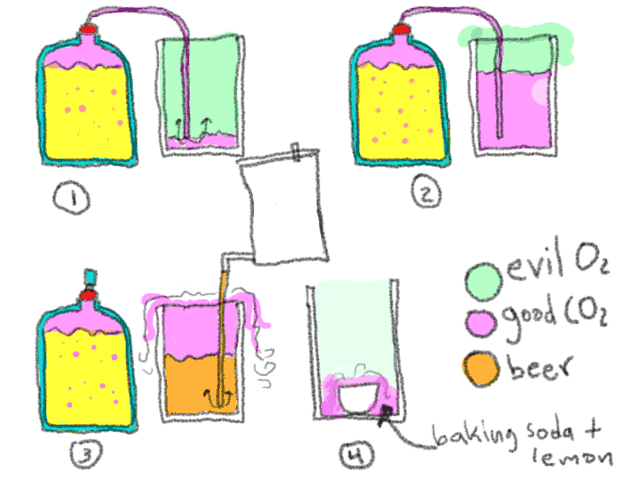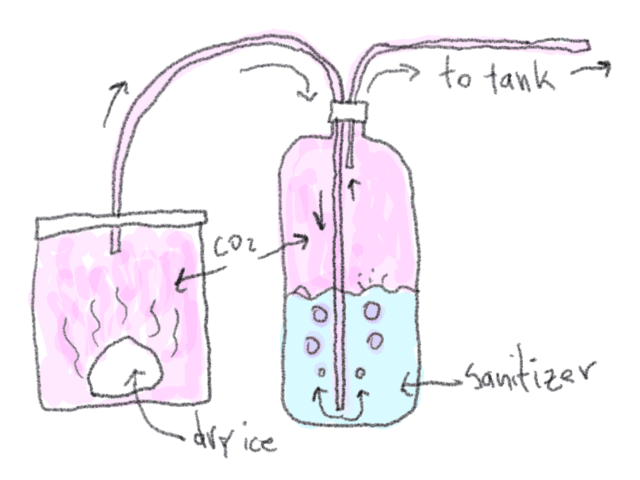salamastre
Member
First time poster, long time lurker.
I am pretty much a noob to beer brewing, with only 1 finished batch and 2 on the way, but I have a lot of experience with planted aquariums, fish breeding and gourmet mushroom growing. These hobbies are a lot more similar than most people think (Sanitation? I've sanitized a whole bathroom to make clean spore cultures).
All the CO2 that gets 'wasted' during primary fermentation makes me sad. I've had elaborate setups to supply CO2 to the plants in an aquarium and to lower the relative oxygen concentration to promote mushroom growth.
I decided to use the waste CO2 from a primary fermenter to prevent oxidation during the racking of another primary to a secondary.
I actually tried what I am going to show, it may work, it may not, but it is easy, free, and I like to experiment. I hope it will minimize oxygenation during racking, and it could be used for bottling or any other oxygen sensitive part of the process. It may not be an original idea, but I could not find any mention here.

In few words:
1- Use the CO2 from a vigorous primary to displace the oxygen (in the air that is) in the secondary.
2- CO2 is heavier than air, so it should remain in the bottom.
3- Once you think there is a nice layer of CO2, proceed with your normal racking. There should be a nice layer of CO2 protecting your precious wort from the evil atmosphere.
4- If you dont have another primary bubbling during racking, you can create the CO2 with lemon juice and baking soda, a yeast starter, from a pressurized tank or from your dog's breath.
5- Enjoy.
If at bottling time I have a bubbling fermenter, I may put some CO2 in some bottles to see if it makes a difference.
I hope this is useful. If this is doomed to fail, an old idea, just stupid or boring, please let me know.
Thank you for your time.
I am pretty much a noob to beer brewing, with only 1 finished batch and 2 on the way, but I have a lot of experience with planted aquariums, fish breeding and gourmet mushroom growing. These hobbies are a lot more similar than most people think (Sanitation? I've sanitized a whole bathroom to make clean spore cultures).
All the CO2 that gets 'wasted' during primary fermentation makes me sad. I've had elaborate setups to supply CO2 to the plants in an aquarium and to lower the relative oxygen concentration to promote mushroom growth.
I decided to use the waste CO2 from a primary fermenter to prevent oxidation during the racking of another primary to a secondary.
I actually tried what I am going to show, it may work, it may not, but it is easy, free, and I like to experiment. I hope it will minimize oxygenation during racking, and it could be used for bottling or any other oxygen sensitive part of the process. It may not be an original idea, but I could not find any mention here.

In few words:
1- Use the CO2 from a vigorous primary to displace the oxygen (in the air that is) in the secondary.
2- CO2 is heavier than air, so it should remain in the bottom.
3- Once you think there is a nice layer of CO2, proceed with your normal racking. There should be a nice layer of CO2 protecting your precious wort from the evil atmosphere.
4- If you dont have another primary bubbling during racking, you can create the CO2 with lemon juice and baking soda, a yeast starter, from a pressurized tank or from your dog's breath.
5- Enjoy.
If at bottling time I have a bubbling fermenter, I may put some CO2 in some bottles to see if it makes a difference.
I hope this is useful. If this is doomed to fail, an old idea, just stupid or boring, please let me know.
Thank you for your time.



